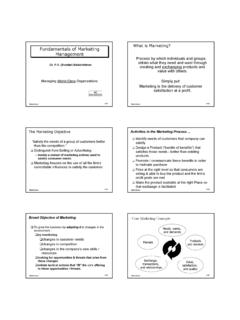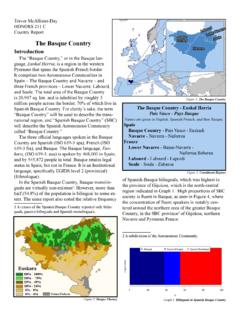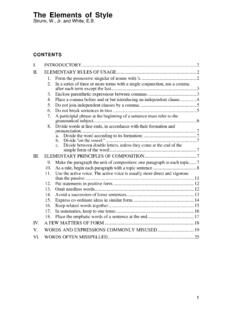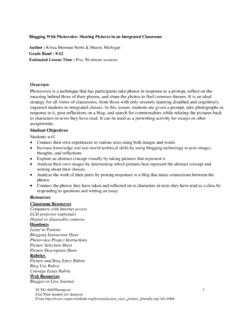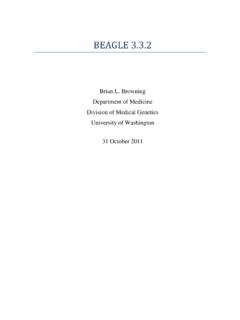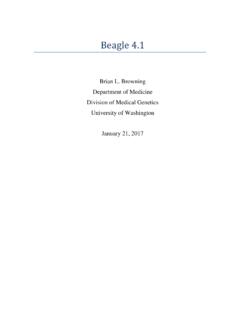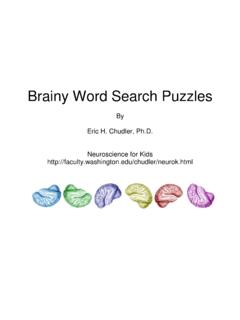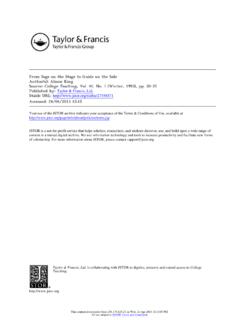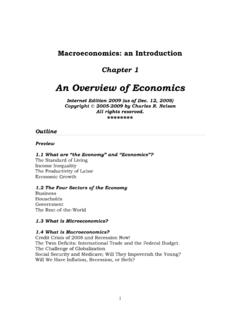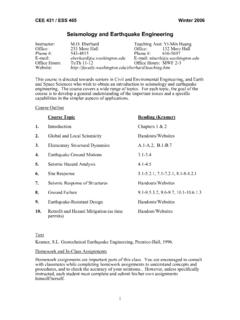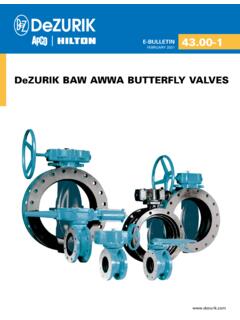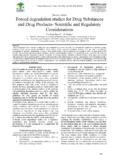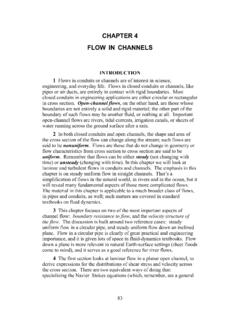Transcription of Lecture 9 – Introduction to Rock Strength David Hart ...
1 Lecture 9 Introduction to Rock StrengthDavid HartUniversity of -ROCK Strength Shear fracture is the dominant mode of failure for rocks under all but the lowest confining from Goodman, Intro to Rock MechanicsPaterson, Experimental Rock Deformation The Brittle FieldExtensionCompressionROCK Strength The peak stress is the Strength of the rock. It may fail catastrophically if the load frame is soft . Example below is for a stiff frame. The compressive Strength of rock is a function of the confining pressure. As the confining pressure increases so does the Strength . Goodman, Intro to Rock MechanicsROCK Strength The variation of peak stress 1, peak(at which failure occurs) with the confining pressure (for which 2= 3) is referred to as the rock CRITERION OF FAILURE. The simplest and the best known failure criterion of failure is the MOHR-COULOMB(M-C) criterion: the linear approximation of the variation of peak stress 1, peakwith the confining Criterion of Failure It has been established that rock fails in compression by shearing along a failure plane oriented at an angle with respect to 1that is specific for a particular rock.
2 The M-C linear Strength criterion implies that stays the same regardless of the confining pressure cylinder 1,p 2= 3 2= 30 1,p2 2 2 MOHR-COULOMBC riterion 90o 1,p 2= 3 BACS criS=+tanD0Co2 MOHR-COULOMBC riterion in terms of shear and normal stress on the plane of failurewhere I lcris the shear Strength , Si(cohesion) is the intercept with the axis of the linear envelope, and ('angle of friction') is the slope angle of the linear envelope of failure. criS=+tan245 or 22o +=+=The relationship between the angle (the angle between the normal to the plane of failure -point A- and the direction of the max. principal stress ) and isMOHR-COULOMBC riterionand you get: tanSicr+= 2221sin = 2222121cos ++= tancosSsinp,p,ip, +++= 22222212121 The Mohr-Coulomb criterion can also be given in terms of the principal stresses.
3 To do this we recall the following relationships:Plug these relationships into the Mohr-Coulomb criterion:MOHR-COULOMBC riterion in Terms of Principal StressesBy separating all the terms containing 1from the rest of the expression, and recalling the above relationship between and (and also performing some trigonometric manipulations), we finally obtain the Mohr-Coulomb criterion in terms of the principal stresses only:or: + + + =2452452221 tantanSip, + +=2452201 tanCp,MOHR-COULOMBC riterion in Terms of Principal Stressesor:Remember: the angle 45+ /2 is equal to , where is the angle between the direction of 1and the normal to the plane of failure. + + + =2452452221 tantanSip, + +=2452201 tanCp,10 +=245tanS2 Coio +245tano2 32 =1 ExampleThe criterion of failure of a limestone is given by (in MPa):Represent the same criterion in terms of principal stresses.
4 Cr=10+ SolutionFrom the given equation we deduce that: Si= 10 MPa, and tan = , or = . The criterion of failure in terms of principal stresses is: + + + = , + + + =2452452221 tantanSip,By plugging the given values in the above equation we obtain (in MPa):2. Uniaxial compression:Failure occurs when 1 attains its peak value Co. Failure plane (point A) normal is at =(45 + /2) to 1direction. 1 0 ; 2= 3= 0 O BADSi 1,p=Co OP1. Hydrostatic state of stress : 1= 2= 3= P When does rock fail under this condition?EXAMPLES OF MOHR-COULOMB CRITERION:MOHR-COULOMBC riterion-Tensile StressesQuestion: What if the normal stress on the plane of failure is tensile? This implies that there is no contact between the two created surfaces and hence there is no frictional resistance.
5 Thus, the Mohr-Coulomb (M-C) criterion loses its validity. Note, however, that 2can be tensile as long as the normal stress remains compressive: Mohr-Coulomb criterion will still be valid. Remember that 2= 3can never be less than the tensile Strength of the rock T, since T implies tensile StressesCase I: 2and are both tensile, so M-C criterion does not apply. Specimen fails in tension when 2= II: 2is tensile, but is zero or larger, so M-C criterion DOES apply!Case III: All stresses are compressive so M-C does apply. NOTE:Typically T = CRITERION IN TERMS OF THE PRINCIPAL stress RATIO KEngineers/practitioners like to to work with principal stress ratioK = 2 / 1(typically 2represents the horizontal stress h, and 1represents the vertical stress v).It is thus more convenient on occasion to express the Mohr-C criterion in terms of K.
6 MOHR-COULOMB CRITERION IN TERMS OF THE PRINCIPAL stress RATIO KUsing K and rearranging terms, we obtain: 1,p = Co + 2 tan2 (45 + 2)1 = Co 1,p + 2 1,p tan2 (45 + 2)Co 1,p = 1 - Ktan2 (45 + 2) 1,p = Co1 - Ktan2 (45 + 2)Given:We divide both sides by 1,p:MOHR-COULOMB CRITERION IN TERMS OF THE PRINCIPAL stress RATIO KWith the M-C criterion written this way we can determine a limit for the ratio K at failure. It is This condition makes the criterion feasible. Otherwise the failure stress is infinite or negative, which is not physically < cot2 (45 + 2)MOHR-COULOMB CRITERION IN TERMS OF THE PRINCIPAL stress RATIO KThis condition for K is a useful tool in determining stability. For example if the angle = 40 then K < 2 < : What if the angle = 0 ?Determining the Critical State of Stressat a Point in a Rock Formation When the M-C Criterion of Failure and One of the Principal Stresses Are KnownIn this example the Strength material properties of the rock Siand are given, and we also know the 1,pat failure.
7 What is then the complete state of stress at the point in question? cr = Si + tan 1,pGivenLet s imagine first that we have solved the problem, we have found the CRITICAL Mohr circle denoting the state of stress at failure. 1,p 90 + RR= 45 / 2180 (90 + )2 BAC 2We notice that in the triangle ABC two of the sides are equal to the radius R. Also, recall the value of the angle ABC. Hence the angle ACB is 45 - , in order to construct the critical Mohr circle we fist plot the M-C criterion and the point representing 1,p. 1,p 90 + RR= 45 / 2180 (90 + )2 BAC 2 Then, we construct the angle ACB and draw the line CA, where A intersects the M-C we construct an identical angle CAB and draw AB. Point B on the axis is the center of the critical Mohr alternate way is to construct at point A a 90 angle and draw line AD.
8 Point D has to be equal to 2. 1,p (90 + )= 45 / 2180 (90 + )2 BAC 2 IIIIIaDOTHER EMPIRICAL MOHR ENVELOPESA straight line doesn t always fit the data wellMohr-Coulomb is an approximationGoodman, Intro to Rock MechanicsOTHER EMPIRICAL MOHR ENVELOPESS everal examples of other expressionsdefining the Mohr envelope in rocks forwhich the Coulomblinearrelationship doesnot appear to be representative, can befound in the are allEMPIRICAL Hoek andBrown criterion is particularly popular now:where mand s are constants of the material and are determined empirically. 1,pCo= 2Co+m 2Co+sSIZE EFFECT ON COMPRESSIVE STRENGTHIt has been found through experimentationthat rock Strength is affected by theSIZE ofthe specimen tested. This can be explainedsimply as being the result of the many flawsfound in rock in the form of fissures, pores,cleavage, bedding planes, foliation, larger the size of the specimen testedthe higher the probability that a weak flawwill be available, capable of initiating COMPRESSIVE STRENGTHCo (x 1000 psi)050100150 SPECIMEN LENGTH L (in.)
9 VARIATION OF COMPRESSIVE Strength WITH SIZECo = 35 x this plot of the size effect on Strength , a power function was used to best-fit the experimental data. NOTE, however, that beyond L=36 in. the size effect ceases to be of much EFFECT OF PORE PRESSUREON STRESSES IN ROCKRock is a porous material. If these pores are occupied by water (or other fluids such as oil) then they are subjected to some fluid pressure. This is what we call 'pore pressure'.THE EFFECT OF PORE PRESSURE ON ROCK stress AND STRENGTHR ecognizing that a typical rock is pervaded by a network of interconnected pores and fissures, we can represent an incremental volume of it by a solid cube of rock with a hole in it representing the accumulated pore volume in that cube. yy xx xyPoIt has been determined empirically that ROCK Strength is a direct function of the EFFECTIVE stress , :() tanPSicr0 +=() + += 245202001 tanPCPp,zxyzxyijijijzzyyxxiii,,',,P' === = here w where0 yy xx xyPoWe call the EFFECTIVE stress ( effor ') the net stress acting in the rock as a whole.
10 Its value can be obtained straight from this cartoon:CRITICAL PORE PRESSUREIt is obvious that pore pressures REDUCES the net normal stress on the eventual plane of failure, and thus brings about failure at principal stress levels that would be stable PORE PRESSUREIt is often required to calculate the CRITICAL PORE PRESSURE Pcrthat would cause failure under a givenstate of stress ( solid or total stress ). All we have to do is to isolate Po = Pcrin the above equations: tanPtanScri += tanSPtantanSPicricr += += CRITICAL PORE PRESSUREA similar derivation of the M-C equation interms of effective principal stresses canisolate the critical pressure Pcrleading tocompressive failure for a given set ofotherwise stable principal stresses:or:() + += 2452201 tanPCPcrcr124520212 + = tanCPcrPORE PRESSURE EFFECT ON STRESSES IN A MOHR DIAGRAM 11 22BP0 State of TOTAL stress at point B 11 22 BState of TOTAL stress at point BEFFECTIVE STRESSES IN A MOHR DIAGRAM 11 22P0 11 22 State of TOTAL stress at point BState of EFFECTIVE stress at point BP0 CRITICAL PORE PRESSURE USING MOHR DIAGRAMThe Mohr circle can be very effectively used to obtain Pcrleading to failure for a state of total stress which is otherwise in a stable condition.
